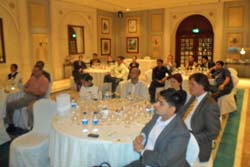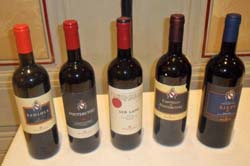Photos By:: Adil Arora
 Founded in 1435, the 600hA Estate of Castello di Fonterutoli is not only one of the oldest family owned estates being run by the 24th generation of Marchesi Mazzei with two of the Mazzei brothers Filippo and Francesco at the helm, it is one of the top rated and highly regarded estates of Italy. Founded in 1435, the 600hA Estate of Castello di Fonterutoli is not only one of the oldest family owned estates being run by the 24th generation of Marchesi Mazzei with two of the Mazzei brothers Filippo and Francesco at the helm, it is one of the top rated and highly regarded estates of Italy.
Alessandro Vallecchi was educated as an agronomist in Florence and later at the University of California, Davis, where he received a BS in International Economics and a MSin Food Marketing. Since 1989, he has been working in the wine business and has held important positions in several premium wineries including Frescobaldi Group where he was also involved in the launch of Luce della Vite and Allegrini.
He went back to his native Tuscany in the beginning of this year and started working with Marchesi Mazzei family, which owns Castello di Fonterutoli and partners with several other wineries within Italy and overseas, in individual capacities. Besides his main responsibility for the Chianti Classico winery, his job also includes managing the Middle Eastern, Asian and Australian markets.
He was in India to help the newly appointed distributor, Sonarys India introduce wines in the market, meet customers and conduct guided tastings. Fonterutoli wines are already present at the Hyatt Regency and should be available soon at the knowledgeable restaurants which have clientele who understand and appreciate fine Tuscan wines including Chianti Classico.
After giving a brief history of the company, Alessandro took the full house seated in one section of Kamal Mahal at ITC Sheraton Hotel a glimpse of how the historical winery has been making different wines from its estate, each giving different expressions to this protagonist grape variety of most of the Tuscan wines-certainly in Chianti Classico where a minimum of 80% of must be used to earn the famous Black Rooster from the Consorzio which oversees the quality and appellation standards of this premium wine region.
Tasting Fonterutoli wines
Badiola IGT Toscana 2008 is medium bodied young, basic wine with lots of berry aromas. Made with only 70% Sangiovese- balance Merlot makes it obligatory for the wine to choose the IGT appellation. Exposure to second and third use of oak for 3-6 months has given the wine a bit of structure and personality. Soft tannins make it good for simple and casual foods. The end is rather short. Wine is drinking well now and should be finished within a couple of years. Typical acidity of Sangiovese makes it a perfect dish for pizzas and tomato-based pastas or even chicken. Truly a vegetarians’ delight. 
Fonterutoli Chianti Classico DOCG 2008. This is the most common wine of the Castello and brings out the true expression of Sangiovese which is 90%, the balance being the typical grapes of Chianti-Malvasia Nera and Colorino and 5% of Merlot which is being growingly used as part of the 20% allowed in Chianti Classico. More concentrated fruit and fuller on the mouth, the wine is juicy because of the acidity that has kept it very fresh. The flavour is full of chocolate and coffee besides black cherries. It has longer aftertaste and prevails on the mouth, always begging for the next sip. Besides the antipasti, it would be good for Indian kebabs, if not too spicy and keema parathas. The tannins should be rounded off better next year and it should be drinkable for 3-5 years 
Ser Lapo Chianti Classico Riserva DOCG 2006: This CC Riserva has seen over 2 years of aging in the barrel, according to the Riserva appellation laws. The wine has been named after and is thus dedicated to the ancestor of  Mazzeis- Ser Lapo, who according to the history of Tuscan wines, authored the first official document on Chianti wines in 1398, four decades before the Mazzei set up the Castello di Fonterutoli winery in 1435. The bottle has the original manuscript on the label. Mazzeis- Ser Lapo, who according to the history of Tuscan wines, authored the first official document on Chianti wines in 1398, four decades before the Mazzei set up the Castello di Fonterutoli winery in 1435. The bottle has the original manuscript on the label.
Besides coming from the older vines of Caggio vineyards, the tannins are harsher and dryer making this wine more tannic and definitely a food wine which would be most appropriate with red meats like game, lamb, and duck etc. A full bodied wine, it could be decanted or would change its character in the big Bordeaux glass. Quite elegant, balanced wine that would show tamed tannins in a year or so, it was quite full on the palate, right till the end which incidentally was very long. 
Castello di Fonterutoli DOCG 2006: This is the signature wine from the Mazzei fratelli (brothers) who have been working with Carlo Ferrini as the consultant winemaker since 1991 when their father Lapo Mazzei was still the President of the Consorzio of Chianti Classico where Ferrini used to work. Dubbed as the Tuscan Wine Houdini by delWine, Carlo’s stamp is visible in every glass of this complex wine he has made from the 45 different plots each measuring around one hectare each. With 36 biotypes of Sangiovese-some clones and some types, each vinified in a separate micro-fermentation tank, its like 45 different musicians each contributing to a beautiful symphony conducted by Ferrini.
Powerful and fruit driven and with the composition of 10% ripe Cabernet Sauvignon, it is very well structured and homogenous wine although the tannins are still not fully rounded in the bottle and it will age nicely for the next couple of years. At the tasting, it opened up in the glass slowly, bringing out its charm and seductive and spicy qualities with layers of fruits ranging from black cherries to plums with hints of white pepper and earthiness and even slight minerality in the back layer making it quite complex. Rather long at the end, the flavours persist. It is almost a meditation wine that shines with properly matched food. 
Castello di Fonterutoli Siepi IGT Toscana 2006
Every Chianti Classico producer worth his Sangiovese produces a top level red wine which breaks the rules of the Classico land and is classified unofficially as a ‘Super Tuscan’ which due to the low production and the use of the best grapes with very low yields give a complex wine that has the possibility of making a collector’s item or an iconic wine. Since Siepi was initially released from the ’92 vintage around when Carlo joined as the consultant winemaker, it is not yet established how long the wine can age but Alessandro ventured to say it could age 20 years and beyond.
 It would be unfair to rate this wine (which I would rate at 9.5/10) but the 200-300 cases made would make it possible to send only a few cases to India which Sanjay Menon of Sonarys should not have any problem to dispose off and you and I would never be able to find it on any Hotel’s Menu (at least in the cellar). But it would show its best still after 2-5 years only. Some restaurateur should snap it up and keep it away from the gaze of the accountants for 3-5 years when they can charge good premium. It would be unfair to rate this wine (which I would rate at 9.5/10) but the 200-300 cases made would make it possible to send only a few cases to India which Sanjay Menon of Sonarys should not have any problem to dispose off and you and I would never be able to find it on any Hotel’s Menu (at least in the cellar). But it would show its best still after 2-5 years only. Some restaurateur should snap it up and keep it away from the gaze of the accountants for 3-5 years when they can charge good premium.
Alessandro’s visit should be a booster shot for Menon who has been disappointed about Antinori withdrawing from him, after he promoted the extensively for almost a decade. He now wants to prove that the next label he picks will enjoy the same popularity. Castello dei Fonterutoli could be the answer for him although the supply position and quality service well turn out to be his nemesis once again.
Subhash Arora
|